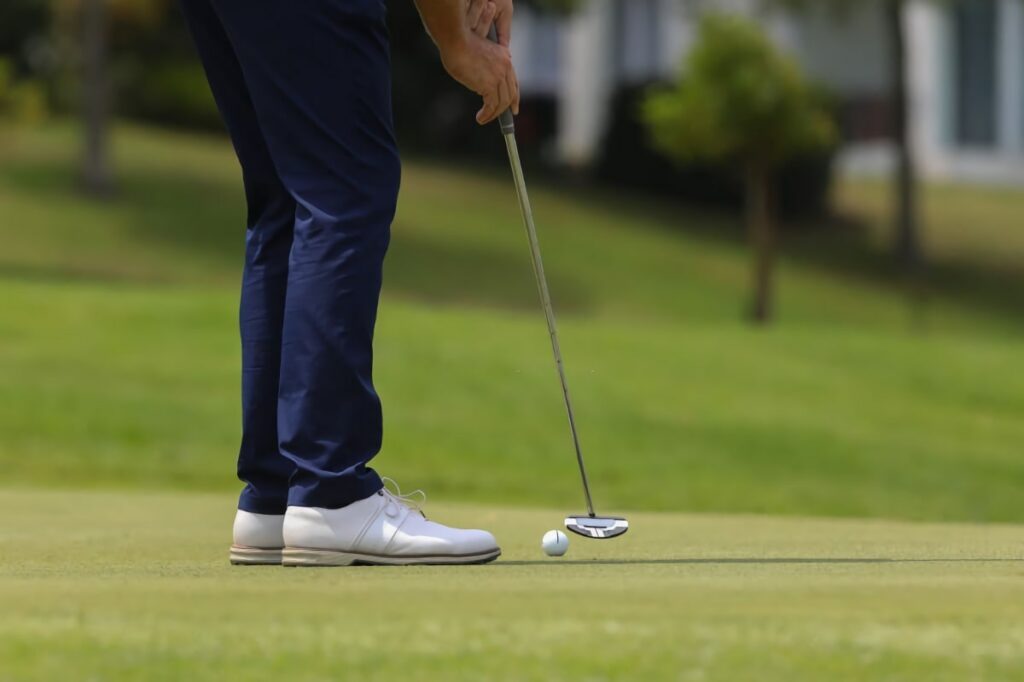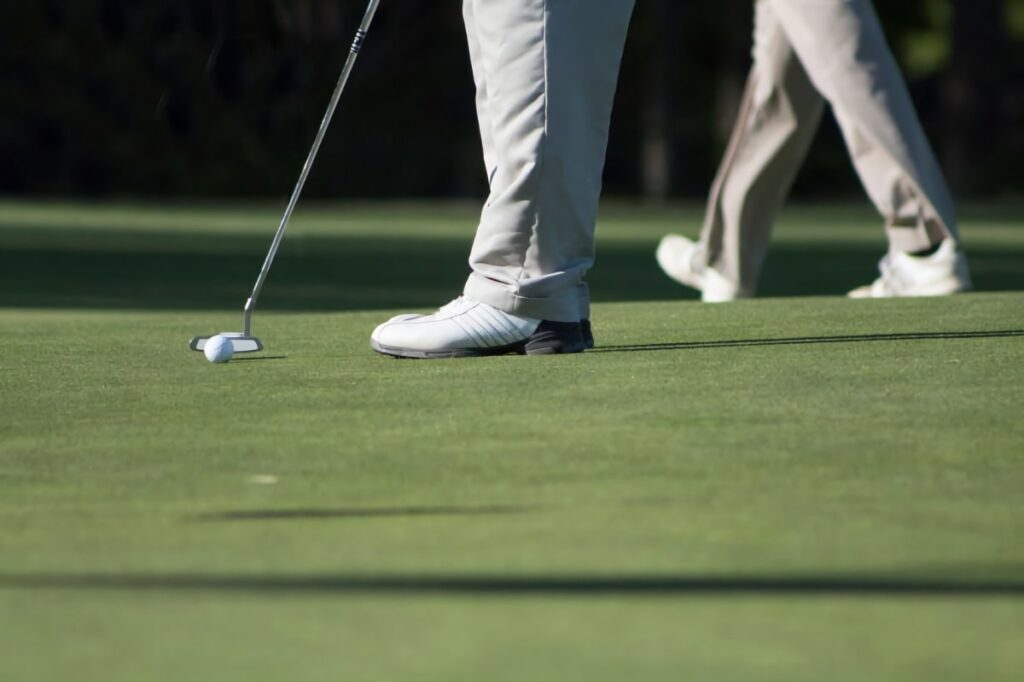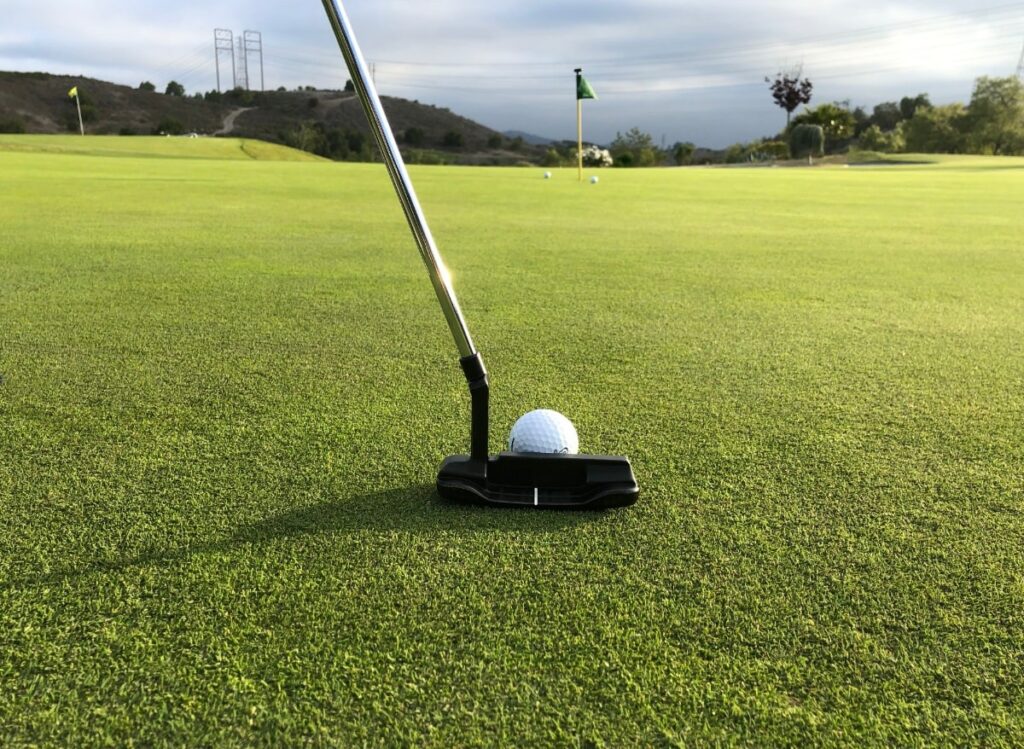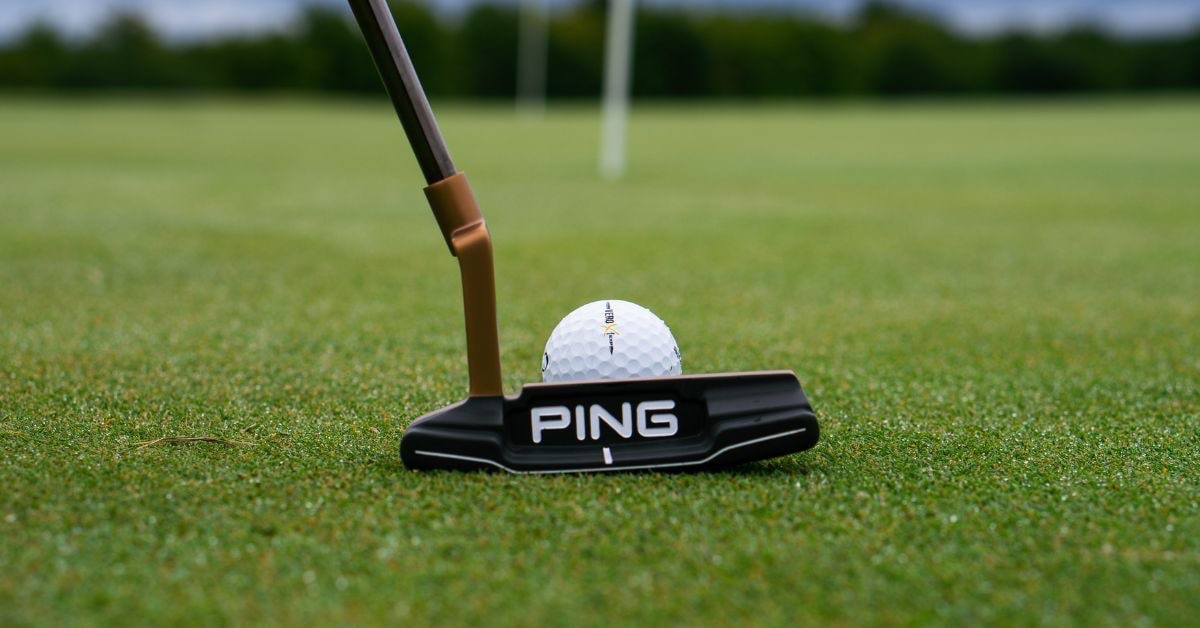As golfers, we’re often quite picky when it comes to the types of putters we use.
Typically, choosing a putter is based on two items of criteria: looks and feel.
The putter needs to look good behind the ball, inciting a feeling of confidence in the stroke. At the same time, it’s equally crucial for the putter to feel good in our hands.
While several factors contribute to feel — like the type of grip, the putter length, and whether it’s a blade or mallet — the putter swing weight must also be considered.
In this article, I’ll explain what putter swing weight is, why it’s important to consider, how to measure it, and how to alter it should you choose to.
Ready? Let’s dive into it!
What Is Putter Swing Weight?
Essentially, putter swing weight is how heavy the putter feels when you swing it. It’s dictated by the combined weight of the head, shaft, and grip — along with the length of the putter. Putters are measured on a swing weight scale ranging from C0 to E9.

What’s an Ideal Putter Swing Weight?
Simply put, there isn’t a perfect putter swing weight that will suit every player. We all have different needs and requirements — such is human nature.
Swing weight is the measure of the weight of a putter in the swing. It combines the head weight, shaft weight, and grip weight — along with the overall length.
Rather than being measured in grams, swing weight is recorded using a letter-number system invented in the 1920s. The lightest swing weight is C0; the heaviest is E9.
Broadly categorized, we can use the following ranges:
- Light (C0-C9)
- Medium (D1-D9)
- Heavy (E1-E9)
Light vs Heavy Putter Swing Weight
There are a few things to consider when deciding on your optimal putter swing weight, like your putting mechanics and style, and the pace of your greens.
In short, swing weight has a bearing on both the feel and performance of a putter.
According to Golf.com — “heavier putters tend to be easier to swing smoothly, while lighter putters tend to be easier to dial in your distances with.”
Therefore, it’s safe to assume that the stable stroke of a heavier putter will perform better on short putts, while lighter putters are preferred for longer putts.
However, you should also take into consideration the pace of the greens you play most frequently on. If you tend to play on faster greens, you’ll likely prefer to use a putter in the lighter range. If you play on slower greens, you may prefer something heavier.
For instance, tour pros will often switch putter weights depending on which competition they are playing in — according to the speed of the greens.

How Does Shaft Length Affect Swing Weight?
According to Scotty Cameron, one inch of shaft equals 6 swing weight points.
So, if the same putter head is used for both a 33″ and a 35″ version — the difference in swing weight will be 12 swing points. This will feel drastically different on the green.
To combat this, some manufacturers produce different head weight variations. For instance, Evnroll states that their putters are milled to two different head weights. Then, they use “different weight grips to dial in a consistent swing weight for each length.”
Another solution is to use tungsten inserts of various weights, in correspondence with the shaft length. One of the pioneers of this system is Scotty Cameron, who advocates using adjustable weighting technology: “A 35-inch putter gets two 10-gram weights; 34-inch has two 15-gram weights; and our 33-inch putters come with 20-gram weights.”
Ultimately, shaft length must be factored into the equation when dialing in your putter swing weight. This is particularly essential when you choose to alter the length.
Popular Putter Models & Their Swing Weights
Let’s take a look at some popular putter models and their swing weights:
| Putter Model | Swing Weight | Category |
| Odyssey White Hot OG Rossie Putter | C6 | Light |
| TaylorMade Spider GTX Putter | C9 | Light |
| Scotty Cameron Phantom X7 Putter | D7 | Medium |
| Titleist Scotty Cameron Newport 2 | E2 | Heavy |
Bear in mind, the difference in swing weight between each measurement is very small.
According to The Golf Warehouse: “all it takes to make a golf club go from a D2 to a D3 rating is about .07 ounces in the club head — approximately the weight of a penny.”
However, over time you will begin to realize how incremental changes in the swing weight can have a significant effect on the overall feel of a putter on the greens.

How to Measure Putter Swing Weight
Since putters are assembled when we buy them, it’s impossible to measure the weight of the head independently — it’s attached to the shaft via the neck.
So, measuring the putter swing weight requires the use of a swing weight scale.
However, it’s unlikely you’ll have one of these lying around at home! Instead, you can reach out to a professional fitter who can measure the swing weight of your clubs.
In the video below by The Golf Works, they discuss the significance of putter weight, and how to measure your putter’s swing weight using a swing weight scale:
How to Adjust Putter Swing Weight
There are three main ways to adjust the putter swing weight:
- Adding lead tape to the head
- Changing the type of grip
- Altering the shaft length
Let’s dive into each of these in some detail.
Option 1: Add Lead Tape
PROS
+ Adds 2 grams per inch
+ Soft and easy to cut
+ Self-adhesive backing
CONS
– Limited amount of weight to add
Adding some lead tape is a quick and effective way to add weight to the putter head.
Lead tape is commonly used to alter the feel of the head on any golf club. It can be easily bought online and applied using self-adhesive backing strips.
I recently added some layers of lead tape to the head of an old Ping Anser Putter from the 80s. This simple method has added stability — it feels like a modern putter!
Option 2: Change the Grip
PROS
+ Embossed ridge guides hand position
+ Uniform profile minimizes grip pressure
+ Grip texture enhances feedback
CONS
– Fat grip style doesn't suit everyone
Opting for a heavier or lighter grip can change the feel of the club’s balance, making the head feel lighter or heavier depending on what you desire.
Simply put, a heavier grip makes the swing weight lighter — and vice versa.
For instance, adding an oversized SuperStroke Traxion Tour Grip will make the grip end of the putter heavier. This reduces the swing weight since the head feels lighter.
Option 3: Alter Shaft Length
Finally, adjusting the length of the shaft will have an impact on the swing weight.
Shortening the shaft by an inch will reduce the swing weight by 6 swing weight points, and lengthening it will increase the swing weight by the same value.

The Importance of Putter Swing Weight
If you’re looking to improve your putting, considering the benefits of fine-tuning the putter swing weight offers a great opportunity to knock shots off your scores.
Here’s how a list of ways a refined swing weight can improve your game:
- Feel & Balance: The weight distribution in your putter influences how it feels in your hands, directly impacting your stroke and performance on the greens.
- Control & Consistency: A well-balanced putter helps you to build consistency, reducing the chances of mishits and off-center hits on the green.
- Distance & Accuracy: Swing weight impacts the distance and accuracy of your putts. A heavier putter can be beneficial over shorter putts, while a lighter putter can enhance the feel on longer putts.
- Performance & Green Conditions: Swing weight plays a critical role on slower greens, where a heavier putter might prove beneficial, while a lighter putter can be more effective on faster greens.
With all of the benefits, though, it always comes down to personal preference.
Putting is crucial in helping you lower your scores; it’s important to settle on a putter that feels and performs the best it can when you’re on the greens.

Final Thoughts
Swing weight is a key factor if you want to be successful at putting. It influences everything from balance and feel, to control and consistency.
The better you understand the impact of putter swing weight and how to adjust it to your preferences, the more likely you’ll be able to make a confident stroke.
Remember, there is no universal putter swing weight. Rather, the optimal swing weight depends on your stroke mechanics, skill level, and personal preferences.
So, don’t hesitate to experiment, adjust, and consult professionals as needed to find your ideal putter swing weight. In the end, the best measure of a putter’s effectiveness is the confidence it gives you when you line up to sink a crucial putt!




